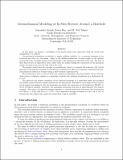Geomechanical Modeling of In-Situ Stresses Around a Borehole
Author(s)
Grandi, Samantha; Rao, Rama V. N.; Toksoz, M. Nafi
DownloadGRANDI.PDF (1015.Kb)
Other Contributors
Massachusetts Institute of Technology. Earth Resources Laboratory
Metadata
Show full item recordAbstract
In this paper, we present a modelling of the in-situ stress state associated with the severe hole
enlargement of a wellbore.
Geomechanical information is relevant to assure wellbore stability, i.e., to prevent damages in the
formation and later on, the casing. Many of the drilling parameters, as mud weight or the optimal
orientation of the borehole, require some knowledge of the mechanical behaviour of the rock. The lack of
these kind of data in exploratory areas, where there are usually insufficient constraints for the geological
model, increases even more the risk, hence the costs.
The present model uses the concepts of poroelasticity theory to compute the stationary 2D, brittle
response of the formation around a borehole that is submitted to effective compressive horizontal stresses.
The numerical solution is obtained using a finite element approximation.
The initial stress state at the far field was estimated combining a frictional-failure theory with the
observations of dipmeter caliper in a particular borehole that presents elongations in a preferential direction.
The direction and relative extension of the observed breakouts at a particular depth are modelled
successfully using formation realistic parameters and dimensions, although the exact shape of the borehole
(at all angles) was unknown. For the particular case study, the orientation of the breakout is NE-SW, at
about 82 degrees azimuth. Therefore, the maximum horizontal stress lies at approximately 350 degrees
azimuth. The ratios of horizontal principal stresses to vertical stress that best honor the observations
are SHmax = 2.3Sv and Shmin = 1.7Sv. The compressive strength necessary for the rock to fail, as
indicated by the caliper data under this stress field, is about 140 MPa.
Date issued
2002Publisher
Massachusetts Institute of Technology. Earth Resources Laboratory
Series/Report no.
Earth Resources Laboratory Industry Consortia Annual Report;2002-06